Match the statements in Column I labelled as a,b,c, and d with those in Column II labelled as p,q,r, and s. Any given statement in column I can have correct matching with one or more statements in Column II

The correct Answer is:A, B, C, D
Topper's Solved these Questions
- THE NUCLEUSBOOK - RESNICK AND HALLIDAYCHAPTER - THE NUCLEUSEXERCISE - PRACTICE QUESTIONS(Integer Type)
7 Videos
- THE NUCLEUSBOOK - RESNICK AND HALLIDAYCHAPTER - THE NUCLEUSEXERCISE - PRACTICE QUESTIONS (Linked Comprehension)
12 Videos
- THE KINETIC THEORY OF GASESBOOK - RESNICK AND HALLIDAYCHAPTER - THE KINETIC THEORY OF GASESEXERCISE - PRACTICE QUESTIONS
72 Videos
- UNITS AND MEASUREMENT BOOK - RESNICK AND HALLIDAYCHAPTER - UNITS AND MEASUREMENT EXERCISE - PRACTICE QUESTIONS (MATRIX-MATCH)
11 Videos
Similar Questions
Match the statements in Column I labeled as (a), (b), (c), and (d) with those in Column II labeled as (p), (q), (r), and (s). Any given statement in Column I can have correct matching with one or more statements in Column II.
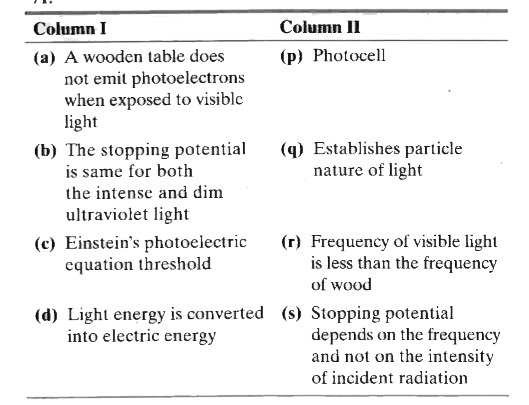
View SolutionMatch the statements in Column I labeled as (a), (b), (c), and (d) with those in Column II labeled as (p), (q), (r), and (s). Any given statement in Column I can have correct matching with one or more statements in Column II.
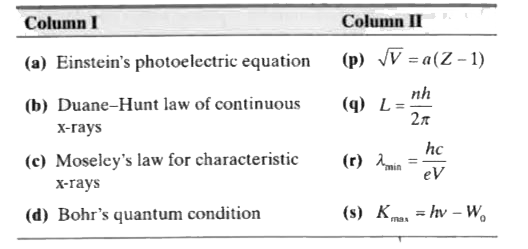
View Solution
Knowledge Check
Match the statements in Column I labeled as (a), (b), (c), and (d) with those in Column II labeled as (p), (q), (r), and (s).Any given statement in Column I can have correct matching with one or more statements in Column II.
Column IColumn II(a)∮→E.d→s=−dϕBdt(p)Maxwell's law of induction(b)∮→B.d→s=μ0ε0dϕEdt(q)Ampere-Maxwell law(c)∮→B.d→s=μ0Ienc(r)Ampere's law(d)∮→B.d→l=u0ε0dϕEdt+μ0Ienc(s)Faraday's law of indcutionA2.8×10−8s−1B3.2×10−8s−1C6×1011s−1DNone of these
Match the statements in Column I labeled as (a), (b), (c ), and (d) with those in column II labeled as (p), (q), (r ), and (s). Any given statement in column I can have correct matching with one or more statements in Column II.
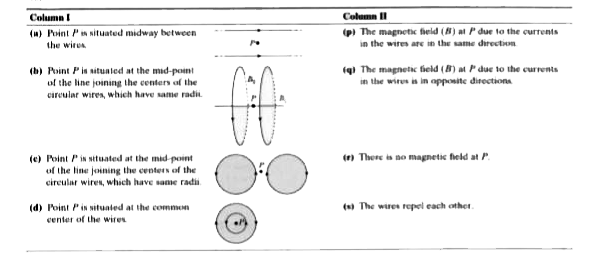
View SolutionMatch the statements in Column I labeled as (a), (b), (c ), and (d) with those in column II labeled as (p), (q), (r ), and (s). Any given statement in column I can have correct matching with one or more statements in Column II.
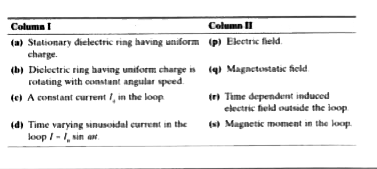
View SolutionMatch the statements in Column I labeled as (a), (b), (c ), and (d) with those in Column II labeled as (p), (q), (r ), and (s). Any given statement in Column I can have correct matching with one or more statements in Column II.
Column IColumn II(a) Lithium atom(p) 54.4 eV(b) Helium atom(q) 13.6 eV(c) Beryllium atom(r) 122 eV(d) Hydrogen atom(s) 217.6 eV
View SolutionMatch the statements in Column I labeled as (a), (b), (c ), and (d) with those in Column II labeled as (p), (q), (r ), and (s). Any given statement in Column I can have correct matching with one or more statements in Column II.
An electron in hydrogen atom moves from n=1 to n=2.
Column IColumn II(a) Angular momentum(p) One-forth times(b) Kinetic energy(q) Two times(c) Potential energy(r) Four times(d) Mechanical energy(s) Half times
View SolutionMatch the statements in Column I labeled as (a), (b), (c), and (d) with those in Column II labeled as (p), (q). (c), and (s). Any given statement in Column I can have correct matching with one or more statements in Column II.
Match the observation given in Column I with the experiments given in Column II.
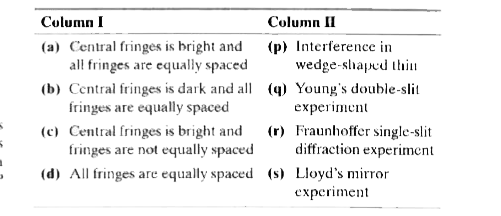
View SolutionMatch the statements in Column I labeled as (a), (b), (c), and (d) with those in Column II labeled as (p), (q). (c), and (s). Any given statement in Column I can have correct matching with one or more statements in Column II.
Match the property with the concept it is based on.
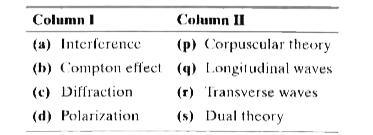
View SolutionAny given statement in column I can have correct matching with one or more statement(s) given in column II. Match the following.

View Solution
